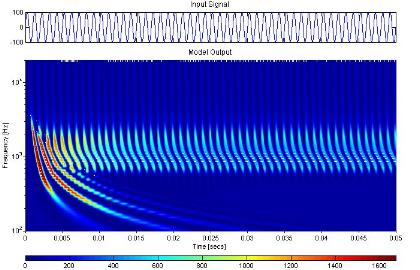David Mountain1, David Anderson1, Glenn Bresnahan2, Socrates Deligeorges1, Andrew Howitt1, Lan Hu1, Lee Lichtenstein1, Diana Ma1 and Viktor Vajda1
1 Hearing Research Center, Boston University
2 Scientific Computing and Visualization group, Boston University
Project Overview
EarLab is a virtual laboratory that is intended to allow scientists from a wide range of backgrounds to perform experiments on large-scale computational models of the mammalian auditory pathways. The EarLab simulations are based on interchangeable building blocks or modules each of which represents a different component of the auditory system or sound-source, data-acquisition and datavisualization systems. The modules are designed to run in a distributed heterogeneous computing environment and to be configured at run time. The physiological modules are designed to be species independent with species dependent parameters loaded from a parameter database at run time. The current system includes modules that represent sound sources, propagation between the source and the tympanic membrane, and the subthalamic auditory pathways.
| Abbreviations | |
|---|---|
| MGB | Medial Geniculate Body |
| IC | Inferior Colliculus |
| NLL | Nucleus of the Lateral Lemniscus |
| LSO | Lateral Superior Olive |
| MSO | Medial Superior Olive |
| MTB | Medial Transport Body |
The overall simulation architecture is designed to be able to represent any physiological system or group of systems. The software is divided into five layers: the User Interface Layer, the Presentation Layer, the Control Layer, the Transport Layer and the Module Layer. The User Interface layer is a standard web browser. The Presentation Layer mediates between the User Interface and the Control Layer, passing user requests to the Control Layer and presenting Control Layer responses to those requests back to the user. The Control Layer manages the simulation environment, maintaining detailed representations of the model states as simulations are created, loaded, executed and examined. The Transport Layer mediates all data transfer between the Control Layer and the Module Layer and between elements of the Module Layer.
The Transport Layer is configured at the beginning of each run to reflect the desired connectivity between Module Layer entities. Once the simulation has been started, the Modules communicate simulation data among themselves mediated by the Transport Layer, as well as communicating status information (current state, computation progress, etc) to the Control Layer, which may then be further summarized and presented to the User as information regarding overall progress in the current simulation.
Simulation Description
This simulation models some of the peripheral auditory processing in mammals, from frequency decomposition of the original signal by the Basilar Membrane (part of the cochlea), through conversion to nanometer-scale displacements of the Inner Haircells (part of the Basilar Membrane), to the conversion to neural signals by the Auditory Nerve (synaptically connected to the Inner Hair Cells). The simulation processes stimuli to both the left and right ears.
Acknowledgments
This research is supported by NIDCD and NIMH, award DC04731.



